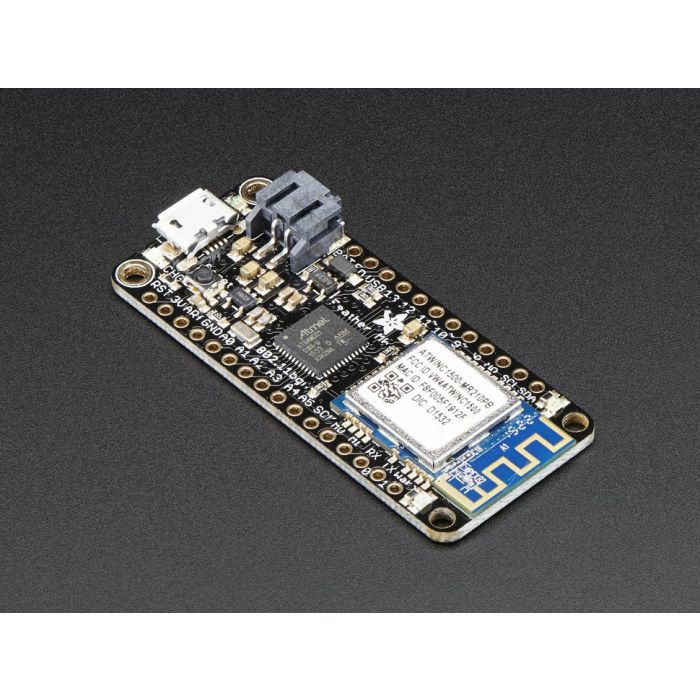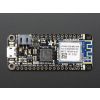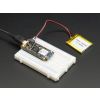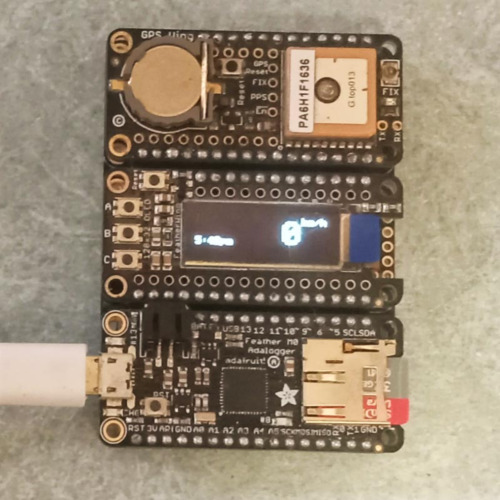Adafruit Feather M0 WiFi - ATSAMD21 + ATWINC1500
Available with a lead time
Expect dispatch between Nov 24 and Nov 27
Quantity Discounts:
- 6+ $67.55 (exc GST)
- 12+ $65.44 (exc GST)
Feather is the new development board from Adafruit, and like its namesake it is thin, light, and lets you fly! Adafruit designed Feather to be a new standard for portable microcontroller cores. This is the Adafruit Feather M0 WiFi w/ATWINC1500 - Adafruit's take on an 'all-in-one' Arduino-compatible + high speed, reliable WiFi with built in USB and battery charging. Its an Adafruit Feather M0 with a WiFi module, ready to rock! Adafruit have other boards in the Feather family, check'em out here.
Connect your Feather to the Internet with this fine new FCC-certified WiFi module from Atmel. This 802.11bgn-capable WiFi module is the best new thing for networking your devices, with built-in low-power management capabilites, Soft-AP, SSL TSL 1.2 support and rock solid performance. Adafruit were running Adafruit's adafruit.io MQTT demo for a full weekend straight with no hiccups (it would have run longer but Adafruit had to go to work, so they unplugged it). This module is very fast & easy to use in comparison to other WiFi modules Adafruit have used in the past.
This module works with 802.11b, g, or n networks & supports WEP, WPA and WPA2 encryption. You can connect to your own WiFi networks or create your own with "Soft AP" mode, where it becomes its own access point (we have an example of it creating a webserver that you can then control the Arduino's pins). You can clock it as fast as 12MHz for speedy, reliable packet streaming. And scanning/connecting to networks is very fast, just a second or two.
You might be wondering why use this when you can get a HUZZAH Feather? Well, you get:
- A highly-capable Cortex M0+ processor with ton more I/O pins, lots of 12-bit ADCs, a 10-bit DAC, 6 total SERCOMs that can each do SPI, I2C or UART (3 are used by the existing interfaces, leaving you 3), plenty of timers, PWMs, DMA, native USB, and more (check out the Datasheet)
- The ATWINC has much lower power usage, about 12mA for the WINC & 10mA for the ATSAMD21 with auto-powermanagement on for the WiFi and no power management for the ARM. With manual power management, you can get the WiFi module to down to ~2mA by putting it to sleep.
- This is compared to the ESP's ~70mA average current draw, and whose deep sleep mode requires a WDT reset.
- They also found that Adafruit could stream more reliably (less 'bursty') with the ATWINC, although altogether the ESP has higher throughput.
- You also dont have to 'yield' all the time to the WiFi core, since its a separate chip. You get full reign of the processor and timing
Of course, both WiFi-capable Feathers have their strengths and tradeoffs, & Adafruit love both equally!
At the Feather M0's heart is an ATSAMD21G18 ARM Cortex M0 processor, clocked at 48 MHz and at 3.3V logic, the same one used in the new Arduino Zero. This chip has a whopping 256K of FLASH (8x more than the Atmega328 or 32u4) and 32K of RAM (16x as much)! This chip comes with built in USB so it has USB-to-Serial program & debug capability built in with no need for an FTDI-like chip. For advanced users who are comfortable with ASF, the SWDIO/SWCLK pins are available on the bottom, and when connected to a CMSIS-DAP debugger can be used to use Atmel Studio for debugging.
To make it easy to use for portable projects, Adafruit added a connector for any of Adafruit's 3.7V Lithium polymer batteries and built in battery charging. You don't need to use a battery, it will run just fine straight from the micro USB connector. But, if you do have a battery, you can take it on the go, then plug in the USB to recharge. The Feather will automatically switch over to USB power when its available. They also tied the battery through a divider to an analog pin, so you can measure and monitor the battery voltage to detect when you need a recharge.
Here's some handy specs! Like all Feather M0's you get:
- Measures 2.1" x 0.9" x 0.3" (53.65mm x 23mm x 8mm) without headers soldered in. Note it is 0.1" longer than most Feathers
- Light as a (large?) feather - 6.1 grams
- ATSAMD21G18 @ 48MHz with 3.3V logic/power
- 256KB FLASH, 32KB SRAM, No EEPROM
- 3.3V regulator (AP2112K-3.3) with 600mA peak current output, WiFi can draw 300mA peak during xmit
- USB native support, comes with USB bootloader and serial port debugging
- You also get tons of pins - 20 GPIO pins
- Hardware Serial, hardware I2C, hardware SPI support
- 8 x PWM pins
- 10 x analog inputs
- 1 x analog output
- Built in 200mA lipoly charger with charging status indicator LED
- Pin #13 red LED for general purpose blinking
- Power/enable pin
- 4 mounting holes
- Reset button
Comes fully assembled and tested, with a USB bootloader that lets you quickly use it with the Arduino IDE. They also toss in some header so you can solder it in and plug into a solderless breadboard. Lipoly battery and MicroUSB cable not included (but we do have lots of options in the shop if you'd like!)
Technical Details
- 53.65mm x 22.8mm x 8mm / 2" x 0.9" x 0.3"
- Weight: 6.1g
- EagleCAD PCB files, Fritzing object, datasheets and more in the tutorial
Exact shipping can be calculated on the view cart page (no login required).
Products that weigh more than 0.5 KG may cost more than what's shown (for example, test equipment, machines, >500mL liquids, etc).
We deliver Australia-wide with these options (depends on the final destination - you can get a quote on the view cart page):
- $3+ for Stamped Mail (typically 10+ business days, not tracked, only available on selected small items)
- $7+ for Standard Post (typically 6+ business days, tracked)
- $11+ for Express Post (typically 2+ business days, tracked)
- Pickup - Free! Only available to customers who live in the Newcastle region (must order online and only pickup after we email to notify you the order is ready). Orders placed after 2PM may not be ready until the following business day.
Non-metro addresses in WA, NT, SA & TAS can take 2+ days in addition to the above information.
Some batteries (such as LiPo) can't be shipped by Air. During checkout, Express Post and International Methods will not be an option if you have that type of battery in your shopping cart.
International Orders - the following rates are for New Zealand and will vary for other countries:
- $12+ for Pack and Track (3+ days, tracked)
- $16+ for Express International (2-5 days, tracked)
If you order lots of gear, the postage amount will increase based on the weight of your order.
Our physical address (here's a PDF which includes other key business details):
40 Aruma Place
Cardiff
NSW, 2285
Australia
Take a look at our customer service page if you have other questions such as "do we do purchase orders" (yes!) or "are prices GST inclusive" (yes they are!). We're here to help - get in touch with us to talk shop.
Have a product question? We're here to help!
Videos
View AllGuides
MicroPython Primer for Makers - What is MicroPython?
CircuitPython vs MicroPython: Key Differences
The Maker Revolution
Wi-Fly with Feather Boards
Projects
Vehicle GPS Logger and Speedometer
Wi-Fly with Feather Boards
Makers love reviews as much as you do, please follow this link to review the products you have purchased.















Product Comments